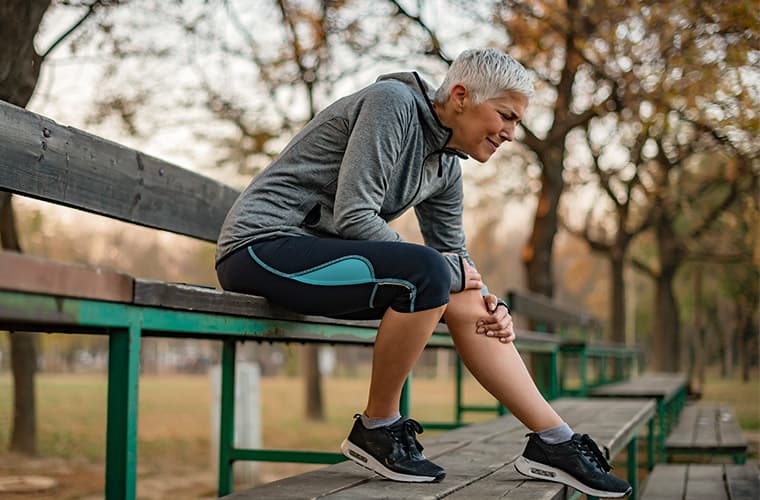
Arthritis does not spell the end to an active life. If anything, exercise is all the more important for people suffering from arthritis. The trick is finding low-impact exercises that strengthen the muscles without exacerbating your symptoms – case in point, isometric exercise.
Isometric exercise is perfect for people with arthritis because it’s completely static; that means minimal joint pain. It’s also unbelievably low-impact, making it the ideal training method for keeping pain and stiffness at bay.
So, in honor of National Arthritis Awareness Month, we’re going over our favorite Activ5 exercises for osteoarthritis and rheumatoid arthritis.
Why Is Exercise Good for Arthritis?
Exercise offers a number of benefits for people suffering from arthritis, such as:
- Maintaining bone strength
- Improving flexibility
- Reducing joint pain
- Fighting fatigue
- Improving balance, posture and coordination
Essentially, the stronger your muscles and connective tissues are, the better you can support your bones and reduce stress on your joints. And with isometric workouts, you can target muscle groups with pinpoint precision without aggravating your hips, hands, shoulders or knees.
Of course, double check with your doctor or physical therapist before performing any exercise. This blog should not be regarded as medical advice, and you should not ignore professional medical advice or attention because of what you read here.
Things to Keep in Mind
What defines an ideal arthritis exercise? There are a few things to keep in mind:
Always Breathe
Cardio is always good–but make sure you’re limiting the amount of time you’re in an anaerobic state. Your body needs oxygen, especially during an intense workout, and a lack of oxygen can intensify some of your symptoms.
Don’t Lean in
Leaning forward or curving your back may seem easier during exercises, but good posture is essential to preventing joint pain. Many pieces of workout equipment have armrests or railings, but it’s important that you don’t use them to lean over during a workout.
Avoid Certain Moves
There are certain exercises that are just plain bad for shoulders, knees, backs, and hips affected by arthritis. Certain exercises that involve arching your back, running and jumping, toe touches, and lifting weights above your waist are not recommended.
Special Instructors
You don’t have to work out alone. A certified instructor or physical therapist can help guide you through proper posture, make sure you’re protecting yourself during workouts, and suggest more gentle alternatives that work within your pain range. Finding a workout class especially for people with arthritis can also be helpful.
When to Work Out
There’s an ideal time to work out, too. For instance, people with morning stiffness should start with gentle stretching workouts in the beginning of the day, while people who have trouble sleeping at night should end the day with soothing, stretching workouts.
Focus on Balance Workouts
Arthritis affects the joints and the surrounding muscles, which means it impairs people’s balance, coordination, and posture. To help with balance, people with rheumatic diseases should try low-impact balancing workouts like Tai Chi, Pilates, and Yoga. Although people should avoid exercises that put excessive weight on the hands, arms, and shoulders–like the downward dog position.
Hand Exercise for People with Arthritis
Gently squeezing your palms is a great workout for arthritis. Putting slow, equal pressure on your hands should do the trick of stretching the muscles while protecting the joints.

Warrior 2:
- From a standing position, hold the Activ5 between both hands in a prayer position
- If you don’t have an Activ5, you can use a tennis ball
- Step your right forward with your toes facing ahead of you
- Bend your right knee at almost a 90° angle
- Make sure your body’s in the same plane
- Gently squeeze the Activ5
- Repeat for the other leg
Hip Arthritis Exercises
Strengthening your hip flexors are a great way to relieve pressure on your hips.
Swimmer Kick:
- Lying on your stomach on a mat, fold your arms in front of you for support or rest your chin on your hands
- Place your Activ5 under your toes on your left foot
- If you don’t have an Activ5, press your toe to the mat
- Press the Activ5 into the mat
- Repeat for the right foot
Knee Arthritis Exercises
Strengthen your quads with this gentle, seated exercise.

Clamshell:
- From a seated position, place the Activ5 sideways between both heels
- If you don’t have an Activ5, you can use a ball
- While squeezing your outer thighs, press the Activ5 with both thighs
Shoulder Arthritis Exercises
Tight shoulders can create a lot of discomfort for the entire upper body, so this isometric shoulder exercise features a nice, satisfying stretch.

Trunk Rotation:
- From a sitting position, use your left palm to hold the Activ5 against the front of your right shoulder
- If you don’t have an Activ5, just directly press on the right shoulder
- Keeping your back straight and your hips square, slightly rotate your torso to the left
- Gently squeeze the Activ5
- Repeat for the other arm
Arthritis shouldn’t prevent you from living your life. Living a healthy, active life is key to maintaining your symptoms and making your day-to-day life easier.
Need the right tools for living with arthritis? You could use an Activ5 to record your progress, track your strength and enjoy cutting-edge isometric workouts you can do anytime, anywhere. Continue your fit lifestyle by downloading the Activ5 Training App for iOS and Android.
